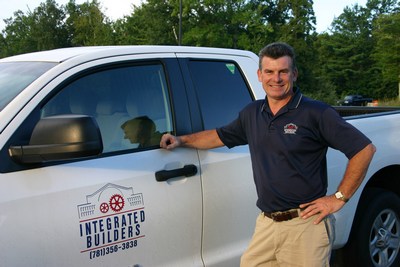
Preplanning, keeping one step ahead lead to success
By Chris Schmidt
Tim Leiter, project superintendent at Integrated Builders, manages onsite job safety, subcontractor coordination and daily reporting and budget/schedule management. His background includes supervising projects up to the $50-million range for corporate, manufacturing, retail and private and public institutions. Join Construction Superintendent as Leiter talks about overcoming challenges on the job, his favorite type of building project and what he likes most about his role as superintendent.
(Q) When did you know you wanted to work in construction and what were the steps you took to make it happen?
Raised in a blue collar family in western Maine, my dad always preached that hard work and a passion for something will bring success. I”d like to think showing initiative and having a hard work ethic created opportunities to advance in the construction industry from a surveyor’s transit man to a seasoned superintendent 30 years later.
(Q) Walk us through a typical day on the jobsite.
It begins at 6 a.m. with my coffee and greeting the guys with a “good morning” as they come onto the job. I do a morning pre-walk between 7-8 a.m. to get a feel for manpower and activities being done that day relative to project schedule. Manpower reports to the office between 9-10 a.m., with phone calls made for subcontractor no shows. From 10 a.m.-3 p.m. I manage the work performed by each trade as far as quality and safety. From 3 p.m. to close I conduct a post-day walk-through to look for safety concerns and quality issues in regard to work in progress per project specifications. Additionally, owner and subcontractor meetings take place on any given day.
(Q) What is a “motto” your subcontractors may hear you say on a regular basis?
Preplan and think of the next person your work affects.
(Q) What is a favorite aspect of your role as project superintendent?
Getting to know the team and making some good friends along the way. Integrated [Builders] has a great community where everyone works together to create the best results possible. Everyone has a story to tell and taking the time to create small talk gets guys to open up and lets them know we are all in it for the same reasons. I believe just taking a moment to say, “Have a good weekend,” or “How was the weekend?” earns you greater respect.
(Q) Talk about the advancement(s) in the construction industry most integral to you and how it’s affected the way you do your job.
iPads and smartphones are making it more efficient and faster to get answers and results to solve project pitfalls with architects and subcontractors that could cause delays.
(Q) Pick a recent project and discuss its challenges and how you overcame them.
Renovation of a 660,000-square-foot old digital manufacturing facility into office space in Salem, New Hampshire. The most challenging work was the installation of two interior 3,600-square-foot courtyards. Each courtyard was constructed of new curtainwalls made with 20-foot birch trees, river rock, ornamental pavers and smaller shrub plantings. The challenge was that each courtyard was at the building’s central low points and we had to keep the building dry inside. We created a temporary dike around the 30 by 120 planned courtyard, and diverted water to other drains while we installed new/relocated drains in the courtyard area. This required preplanning and systematical removal of roof and slab sections, creating an exposed ground area for drainage with sealed perimeter wheel stops that kept water from migrating inward, with interior man lifts out of the hazard area. Timely coordination of the trades, leaving a 300-foot access lane through ongoing construction in order to get 20-foot birch trees and construction materials inside and working our way out of the building, was a daily orchestration of preplanned activities. It’s not every day you have mini excavators and dump trucks adjacent to the finish trades in progress on each side of an access lane. Teamwork made the courtyards a success for all, and a hidden gem for office workers inside of the building.
(Q) What is a common thread between the diverse projects you”ve worked on over the years?
Repeat clients and architects on a regular basis, and providing 110 percent effort and attitude by looking at the project from the owner’s view and expectations. This keeps you one step ahead of most pitfalls and lets them know you really care about their investment.
(Q) Which type of building project do you prefer and why?
Office building work and implementing the architect’s “crazy” ideas inside; e.g., floating ceilings, courtyards, open ceiling areas with fancy accent lighting, etc. This puts a unique touch on each project you complete and keeps the job continuously challenging and fun.
(Q) What has been your biggest challenge as far as subcontractor coordination?
Getting them all to better preplan and care more about the next trade/subcontractor that follows them. If each worker looks ahead and doesn”t delay or create a problem for the next trade, it spells success for a minimal punchlist and timely completion of the project.
(Q) If you could change one thing about your position as project superintendent, what would it be?
Quite honestly nothing, unless a 40-hour week was possible…but what fun would that be?!


 Join our thriving community of 70,000+ superintendents and trade professionals on LinkedIn!
Join our thriving community of 70,000+ superintendents and trade professionals on LinkedIn! Search our job board for your next opportunity, or post an opening within your company.
Search our job board for your next opportunity, or post an opening within your company. Subscribe to our monthly
Construction Superintendent eNewsletter and stay current.
Subscribe to our monthly
Construction Superintendent eNewsletter and stay current.